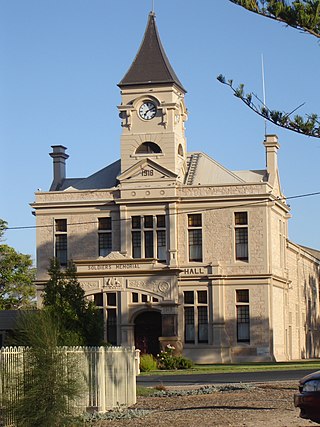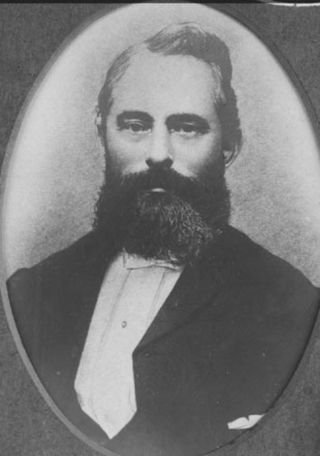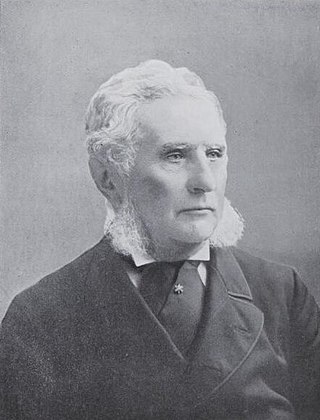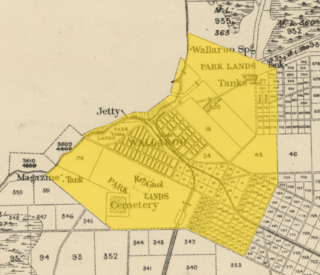Related Research Articles

Wallaroo is a port town on the western side of Yorke Peninsula in South Australia, 160 kilometres (100 mi) northwest of Adelaide. It is one of the three Copper Triangle towns famed for their historic shared copper mining industry, and known together as "Little Cornwall", the other two being Kadina, about 8 kilometres (5 mi) to the east, and Moonta, about 18 kilometres (11 mi) south. In 2016, Wallaroo had a population of 3,988 according to the census held.

Kadina is a town on the Yorke Peninsula of the Australian state of South Australia, approximately 144 kilometres north-northwest of the state capital of Adelaide. The largest town of the Peninsula, Kadina is one of the three Copper Triangle towns famous for their shared copper mining history. The three towns are known as "Little Cornwall" for the significant number of immigrants from Cornwall who worked at the mines in the late 19th century.

Moonta is a town on the Yorke Peninsula of South Australia, 165 km (103 mi) north-northwest of the state capital of Adelaide. It is one of three towns known as the Copper Coast or "Little Cornwall" for their shared copper mining history.

Arnos Vale Cemetery, in Arnos Vale, Bristol, England, was established in 1837. Its first burial was in 1839. The cemetery followed a joint-stock model, funded by shareholders. It was laid out as an Arcadian landscape with buildings by Charles Underwood. Most of its area is listed, Grade II*, on the Register of Historic Parks and Gardens of special historic interest in England.

Copper Coast is a region of South Australia situated in Northern Yorke Peninsula and comprising the towns of Wallaroo, Kadina, Moonta, Paskeville and Port Hughes. The area approximately bounded by Wallaroo, Kadina and Moonta is also known as the Copper Triangle. The area is so named because copper was mined from there in the late 19th and early 20th centuries, a significant source of economic prosperity for South Australia at the time. These three towns are known for their large Cornish ethnicity, often called "Little Cornwall". Kernewek Lowender is the world's largest Cornish Festival, held biennially in the Cornish Triangle. The area continues to make a significant contribution to the economy of South Australia, as a major producer of grain, particularly barley and wheat.

The Copper Coast Council is a local government area in the Australian state of South Australia located at the northern end of the Yorke Peninsula. It was established in 1997 and its seat is in Kadina.

Henry Kneebone was an Australian journalist, author, editor and politician.

Albert John Hockings was a politician in Queensland, before the Federation of Australia. He was a Member of the Queensland Legislative Assembly and an alderman and mayor of the Brisbane Town Council.

Alexander Hay was a South Australian merchant, pastoralist and politician.

Wallaroo Mines is a suburb of the inland town of Kadina on the Yorke Peninsula in the Copper Coast Council area. It was named for the land division in which it was established in 1860, the Hundred of Wallaroo, as was the nearby coastal town of Wallaroo. The boundaries were formally gazetted in January 1999 for "the long established name".
Matta Flat is a suburb of the town of Kadina on the Yorke Peninsula. It is located in the Copper Coast Council. The boundaries were formally gazetted in January 1999, although the name had long been in use for the area.

William Parkin was an English-born businessman, politician and philanthropist. He emigrated to the British Province of South Australia with his wife in 1839 and represented the City of Adelaide in the House of Assembly from 1860 to 1862 before becoming a member of the Legislative Council from 1866 to 1867. Parkin was a benefactor of the South Australian Congregational Church and founded many religious philanthropic efforts.

Pilgrim Uniting Church is a church in the heart of the City on Flinders Street, Adelaide in South Australia. It is a church of the Uniting Church in Australia.

The Balaklava-Moonta railway line was a railway line on the South Australian Railways network. It ran across the top of the Yorke Peninsula.

The Corporate Town of Wallaroo was a local government area in South Australia from 1874 to 1997, centred on the town of Wallaroo.
The District Council of Kadina was a local government area in South Australia from 1888 to 1984.
The Corporate Town of Kadina was a local government area in South Australia from 1872 to 1977, based in the town of Kadina.
Hancock's Billiard Saloon is a heritage-listed former billiard saloon and barber shop at 36-38 Taylor Street, Kadina, South Australia. It is also known as Hancock's Barber Shop and Humphries Barber Shop. It was listed on the South Australian Heritage Register on 28 May 1987 and on the former Register of the National Estate on 1 November 1983.
Matta House is a heritage-listed house in Matta Road, Matta Flat, South Australia. It was listed on the South Australian Heritage Register on 24 July 1980 and on the former Register of the National Estate on 21 March 1978.
Cheltenham Cemetery, originally the Port Adelaide and Suburban Cemetery, Cheltenham but known as Woodville Cemetery, was established in 1876 by the Port Adelaide Corporation. Funds were allocated for the cemetery by the South Australian colonial administration in 1874. The first recorded burial was Mrs. Hannah Mussared on 27 Jul 1876. There is an Islamic cemetery located nearby too.
References
- ↑ "Kadina Cemetery, including the Mortuary and Wall". South Australian Heritage Register. Department of Environment, Water and Natural Resources. Retrieved 29 January 2017.
- ↑ "Mortuary and Cemetery, Drain Rd, Kadina, SA, Australia". Register of the National Estate. Department of the Environment. Retrieved 29 January 2017.
- ↑ "Cemeteries". District Council of the Copper Coast. Retrieved 29 January 2017.
- 1 2 3 Bailey, Keith (1990). Copper City Chronicle: A History of Kadina. p. 151.
- ↑ "Parliamentary Papers". Adelaide Observer . Vol. XIX, no. 1027. South Australia. 8 June 1861. p. 7. Retrieved 6 February 2017– via National Library of Australia.
- ↑ Drew, Greg (1990). Discovering Historic Kadina, South Australia. Department of Mines and Energy and the District Council of Northern Yorke Peninsula. pp. 39, 20.
- ↑ Bailey, Keith (1990). Copper City Chronicle: A History of Kadina. p. 100.
- ↑ Fennescey, John (2005). "Fennescey, John (1866–1948)". Australian Dictionary of Biography . Vol. Supplementary Volume. National Centre of Biography, Australian National University. ISSN 1833-7538 . Retrieved 14 April 2023.
- ↑ Fennescey, Mary Jane (2005). "Fennescey, Mary Jane (1878–1946)". Australian Dictionary of Biography . Vol. Supplementary Volume. National Centre of Biography, Australian National University. ISSN 1833-7538 . Retrieved 14 April 2023.